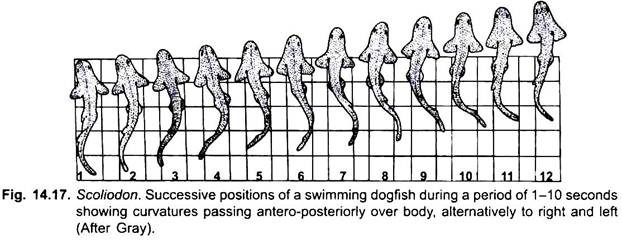The locomotion of fishes has been explained by Breder (1926) and Gray (1933). By taking a series of photographs at definite intervals of time of a swimming fish against a background marked with a graduated scale.
Gray has been able to record:
(a) The motion of the body of the fish relative to the surrounding water, and
(b) The movements of each part of the body relative to the other parts. It has been shown by a series of timed photographs. The entire body of the fish takes part in progression or swimming.
The force which drives a fish through water is produced by longitudinal muscle fibres of myotomes. Their contraction causes the body to bend. Waves of curvature or bending pass alternately on each side of the body from the head to the tail, because the myotomes contract one after the other from before-behind. This bending is more noticeable behind the head region, especially in the tail, because of a progressively greater transverse amplitude of the waves as they pass backwards.
As one wave of contraction passes backwards on one side, it is followed by a similar second wave on the other side of the body. This contraction of successive myotomes causing waves of bending is called metachronal contraction.
In metachronal contractions each segment or part of the body moves in a transverse direction to its path of swimming in such a way that it is bent at an angle or obliquely backwards, so that this part transmits a backward momentum to push the water backwards. Thus, the whole body operates as a single self-propelling system, and the fish is thrust forward.
The role of paired and median fins in swimming is to give stability to the fish and to maintain equilibrium, so that they enable the fish to keep a constant course or to change its course.
ADVERTISEMENTS:
The body is subjected to three forces while swimming in water:
(a) Rolling or turning side-ways or deviating from the longitudinal path of motion, this is called drag,
(b) Pitching or deviating from a transverse plane, this is called lateral force,
(c) Yawing or deviating from a vertical axis by raising or lowering the head, this is called lift.
ADVERTISEMENTS:
The dorsal fins which are fixed in elasmobranchs prevent rolling, thus, keeping the fish steady in a horizontal plane. Equilibrium in a vertical plane is controlled by the moveable pectoral fins, the smallest movement of these fins prevents yawing and restores the original direction of locomotion.
The paired fins and caudal fin prevent pitching. The powerful movements of the heterocercal tail not only give a forward thrust to the fish, but they also make the fish dive head downwards, this is counterbalanced by the paired fins, chiefly the pectoral fins (the pelvic fins have no influence or stability and they are insignificant).
The pectoral fins lie in front of the centre of gravity and act as elevators, forcing the head upwards. Hence, the heterocercal tail and pectoral fins neutralise each other’s effects and maintain the fish in a constant plane. Turning is produced either by a wave of myotomal contraction only on one side of the body, or by asymmetrical braking with the pectoral fins.
